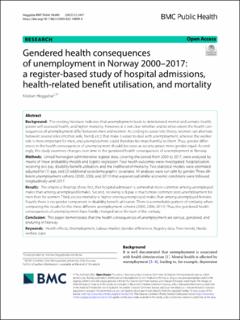| dc.description.abstract | Background: The existing literature indicates that unemployment leads to deteriorated mental and somatic health, poorer self-assessed health, and higher mortality. However, it is not clear whether and to what extent the health consequences of unemployment differ between men and women. According to social role theory, women can alternate between several roles (mother, wife, friend, etc.) that make it easier to deal with unemployment, whereas the worker role is more important for men, and unemployment could therefore be more harmful to them. Thus, gender differences in the health consequences of unemployment should decrease as society grows more gender equal. Accordingly, this study examines changes over time in the gendered health consequences of unemployment in Norway.
Methods: Linked Norwegian administrative register data, covering the period from 2000 to 2017, were analysed by means of linear probability models and logistic regression. Four health outcomes were investigated: hospitalisation, receiving sick pay, disability benefit utilisation, and the likelihood of mortality. Two statistical models were estimated: adjusted for (1) age, and (2) additional sociodemographic covariates. All analyses were run split by gender. Three different unemployment cohorts (2000, 2006, and 2011) that experienced similar economic conditions were followed longitudinally until 2017.
Results: The empirical findings show, first, that hospital admission is somewhat more common among unemployed males than among unemployed females. Second, receiving sick pay is much more common post-unemployment for men than for women. Third, excess mortality is higher among unemployed males than among unemployed females. Fourth, there is no gender component in disability benefit utilisation. There is a remarkable pattern of similarity when comparing the results for the three different unemployment cohorts (2000; 2006; 2011). Thus, the gendered health consequences of unemployment have hardly changed since the turn of the century.
Conclusion: This paper demonstrates that the health consequences of unemployment are serious, gendered, and enduring in Norway. | en_US |

